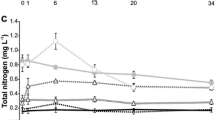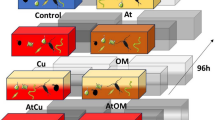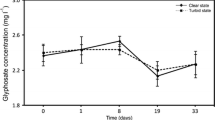Abstract
The study of the joint effect of multiple anthropogenic stressors is important because the emerging consequences are often unpredictable on the basis of knowledge of single effects. We explored the joint impact of glyphosate and the invasive golden mussel Limnoperna fortunei on freshwater phytoplankton, bacterioplankton and periphyton, and on the physical and chemical properties of the water. We manipulated both stressors simultaneously in a 25-day experiment using outdoor mesocosms; we assayed technical-grade glyphosate acid at four concentrations: 0, 1, 3 and 6 mg gly L−1 under scenarios with and without mussels. The addition of the glyphosate significantly increased total phosphorus according to the concentration used; the high clearance rate of L. fortunei significantly decreased phytoplanktonic abundance leading to low values of turbidity. The mussel significantly stimulated the development of filamentous green algae (metaphyton). Interestingly, the combined effect revealed that L. fortunei accelerated the dissipation of glyphosate, which showed a 4-fold decrease in its half-life; this promoted the rapid bioavailability of glyphosate-derived phosphorus in the water. The interaction had a synergistic effect on soluble reactive phosphorus concentrations and was directly dependent on the concentration of glyphosate. A synergistic effect was also observed on bacterioplankton, water turbidity and metaphyton, thus inducing enhanced and rapid eutrophication. The ability of mussels to reduce glyphosate in water may be valued as positive, but our results allow us to predict that the invasion of Limnoperna fortunei in natural freshwater systems contaminated by glyphosate will accelerate the negative impact of the herbicide associated with eutrophication.




Similar content being viewed by others
References
Amrhein N, Deus B, Gehrke P, Steinrücken HC (1980) The site of inhibition of the shikimate pathway by glyphosate. II. Interference of glyphosate with chorismate formation in vivo and in vitro. Plant Physiol 66:830–834
APHA: American Public Health Association (2005) Standard methods for the examination of water and wastewaters, 21st edn. American Water Works Association, Water Environmental Federation, Washington DC, USA
Binelli A, Magni S, Soave C, Marazzi F, Zuccato E, Castiglioni S, Parolini M, Mezzanotte V (2014) The biofiltration process by the bivalve D. polymorpha for the removal of some pharmaceuticals and drugs of abuse from civil wastewaters. Ecol Eng 71:710–721
Boltovskoy D, Cataldo D (1999) Population dynamics of Limnoperna fortunei, an invasive fouling mollusc, in the Lower Paraná river (Argentina). Biofouling 14:255–263
Boltovskoy D, Correa N, Cataldo D, Sylvester F (2006) Dispersion and ecological impact of the invasive freshwater bivalve Limnoperna fortunei in the Río de la Plata watershed and beyond. Biol Invasions 8:947–963
Boltovskoy D, Karatayev A, Burlakova L, Cataldo D, Karatayev V, Sylvester F, Mariñelarena (2009) Significant ecoystem-wide effects of the swiftly spreading invasive freshwater bivalve Limnoperna fortunei. Hydrobiologia 636:271–284
CASAFE (2013) Cámara de Sanidad y Fertilizantes. Informe de Mercado Argentino de Productos Fitosanitarios, año 2013. Buenos Aires, Argentina
Cataldo D, O’Farrell I, Paolucci E, Sylvester F, Boltovskoy D (2012a) Impact of the invasive golden mussel (Limnoperna fortunei) on phytoplankton and nutrient cycling. Aquat Invasions 7:91–100
Cataldo D, Vinocur A, O’Farrell I, Paolucci E, Leites V, Boltovskoy D (2012b) The introduced bivalve Limnoperna fortunei boosts Microcystis growth in Salto Grande reservoir (Argentina): evidence from mesocosm experiments. Hydrobiologia 680:25–38
CCM International (2011) Outlook for China Glyphosate Industry 2012–2016
Darrigran G, Damborenea C (2006) Bio-invasión del mejillón dorado en el continente americano, 1a edn. Universidad Nacional de La Plata, Argentina, La Plata, p 226
Di Fiori E, Pizarro H, dos Santos Afonso M, Cataldo D (2012) Impact of the invasive mussel Limnoperna fortunei on glyphosate concentration in water. Ecotoxicol Environ Saf 81:106–113
Feng JC, Thompson DG, Reynolds P (1990) Fate of glyphosate in a Canadian forest watershed. 1. Aquatic residues and off-target deposit assessment. J Agric Food Chem 38:1110–1118
Folt CL, Chen CY, Moore MV, Burnaford J (1999) Synergism and antagonism among multiple stressors. Limnol Oceanogr 44:864–877
Giesy JP, Dobson S, Solomon KR (2000) Ecotoxicological risk assessment for Roundup® herbicide. Rev Environ Contam Toxicol 167:35–120
Goldsborough LG, Beck AE (1989) Rapid dissipation of glyphosate in small forest ponds. Arch Environ Contam Toxicol 18:537–544
Goldsborough LG, Brown DJ (1988) Effect of glyphosate (Roundup formulation) on periphytic algal photo-synthesis. Bull Environ Contam Toxicol 41:253–260
Goldsborough LG, Brown DJ (1993) Dissipation of glyphosate and aminomethylphosphonic acid in water and sediments of boreal forest ponds. Environ Toxicol Chem 12:1139–1147
Goldsborough LG, Robinson GGC (1996) Pattern in Wetlands. In: Stevenson RJ, Bothwell ML, Lowe RL (eds) Algal Ecology. Freshwater Benthic Ecosystems. Academic Press, New York, pp 77–117
Karatayev AY, Padilla DK, Minchin D, Boltovskoy D, Burlakova LE (2006) Changes in global economies and trade: the potential spread of exotic freshwater bivalves. Biol Invasions 9:161–180
Kelly DW, Poulin R, Tompkins DM, Townsend CR (2010) Synergistic effects of glyphosate formulation and parasite infection on fish malformations and survival. J Appl Ecol 47:498–504
Khoury GA, Gehris TC, Tribe L, Torres Sánchez RM, dos Santos Afonso M (2010) Glyphosate adsorption on montmorillonite: an experimental and theoretical study of surface complexes. Appl Clay Sci 50:167–175
Kish PA (2006) Evaluation of herbicide impact on periphyton community structure using the Matlock periphytometer. J Freshw Ecol 21(2):341–348
Mackereth FJH, Heron J, Talling JF (1978) Water analysis: some revised methods for limnologists. Sci Publ Freshw Biol Assoc 36:1–120
Magbanua FS, Townsend CR, Hageman KJ, Matthaei CD (2013) Individual and combined effects of fine sediment and the herbicide glyphosate on benthic macroinvertebrates and stream ecosystem function. Freshw Biol 8:1729–1744
Mann RM, Bidwell JR (1999) The toxicity of glyphosate and several glyphosate formulations to four species of southwestern Australian frogs. Arch Environ Contam Toxicol 36:193–199
Matthaei Ch, Piggott J, Townsend C (2010) Multiple stressors in agricultural streams: interactions among sediment addition, nutrient enrichment and water abstraction. J Appl Ecol 47:639–649
Mercurio P, Flores F, Mueller JF, Carter S, Negri AP (2014) Glyphosate persistence in seawater. Mar Poll Bull 85:385–390
Millenium Ecosystem Assessment (2005) Fresh Water. Chapter 7. United Nations Emvironment Programme. http://www.unep.org/maweb/en/Condition.aspx
Nusch EA (1980) Comparison of different methods for chlorophyll and phaeopigment determination. Archiv für Hydrobiologie Beihandlungen Ergebnisse der Limnologie 14:14–36
Ormerod SJ, Dobson M, Hildrew AG, Townsend CR (2010) Multiple stressors in freshwater ecosystems. Freshw Biol 55(1):1–14
Pastorino G, Darrigran G, Martin S, Lunaschi L (1993) Limnoperna fortunei (Dunker, 1957) (Mytilidae) nuevo bivalvo invasor en aguas del Río de la Plata. Neotropica 39:101–102
Pérez GL, Torremorell A, Mugni H, Rodríguez P, Vera MS, Do Nascimento M, Allende L, Bustingorry J, Escaray R, Ferraro M, Izaguirre I, Pizarro H, Bonetto C, Morris DP, Zagarese H (2007) Effects of the herbicide Roundup on freshwater microbial communities: a mesocosm study. Ecol Appl 17:2310–2322
Pessagno RC, Torres Sanchez RM, dos Santos Afonso M (2008) Glyphosate behavior at soil and mineral-water interfaces. Environ Pollut 153:53–59
Piggott JJ, Lange K, Townsend CR, Matthaei CD (2012) Multiple stressors in agricultural streams: a mesocosm study of interactions among raised water temperature, sediment addition and nutrient enrichment. PLoS ONE 7(11):e49873
Porter KC, Feig YS (1980) The use of DAPI for identifying and counting aquatic microflora. Limnol Oceanogr 25:943–948
Relyea RA (2006) The impact of insecticides and herbicides on the biodiversity and productivity of aquatic communities. Ecol Appl 16:2027–2034
Reynolds CS (2006) The ecology of phytoplankton. Cambridge University Press, Cambridge, p 164
Stevenson RJ (1996) An introduction to algal ecology in freshwater benthic habitats. In: Stevenson RJ, Bothwell ML, Lowe RL (eds) Algal ecology, freshwater benthic ecosystems. Academic Press, London, pp 1–30
Strayer DL (2010) Alien species in fresh waters: ecological effects, interactions with other stressors, and prospects for the future. Freshw Biol 55(1):152–174
Sylvester F, Dorado J, Boltovskoy D, Juárez A, Cataldo D (2005) Filtration rates of the invasive pest bivalve Limnoperna fortunei as a function of size and temperature. Hydrobiologia 534:71–80
Toghe T, Watanabe M, Hoefgen R, Fernie AR (2013) Shikimate and phenylalanine biosynthesis in the green lineage. Front Plant Sci 4(62):1–12
Townsend CR, Uhlmann SS, Matthaei CD (2008) Individual and combined responses of stream ecosystems to multiple stressors. J Appl Ecol 45:1810–1819
Trochine C, Guerrieri M, Liboriussen L, Meerhoff M, Lauridsen T, Søndergaard M, Jeppesen E (2011) Filamentous green algae inhibit phytoplankton with enhanced effects when lakes get warmer. Freshw Biol 56:541–553
Utermöhl H (1958) Zur vervollkommung der quantitativen Phytoplankton Methodik. Mitteilungen Internationale Vereinigung für Limnologie 9:1–38
Venrick EL (1978) How many cells to count? In: Sournia A (ed) Phytoplankton manual. UNESCO, Paris, pp 167–180
Vera MS, Lagomarsino L, Sylvester M, Pérez GL, Rodríguez P, Mugni H, Sinistro R, Ferraro M, Bonetto C, Zagarese H, Pizarro H (2010) New evidences of Roundup® (glyphosate formulation) impact on the periphyton community and the water quality of freshwater ecosystems. Ecotoxicology 19:710–721
Vera MS, Di Fiori E, Lagomarsino L, Sinistro R, Escaray R, Iummato MM, Juárez A, Ríos MC, Tell G, Pizarro H (2012) Direct and indirect effects of the glyphosate formulation Glifosato Atanor® on freshwater microbial communities. Ecotoxicology 21:1805–1816
Vera MS, Juárez AB, Pizarro H (2014) Comparative effects of technical-grade and a commercial formulation of glyphosate on the pigment content of periphytic algae. Bull Environ Contam Toxicol 93(4):399–404
Vereecken H (2005) Mobility and leaching of glyphosate: a review. Pest Manag Sci 61:1139–1151
Wetzel RG (2001) Limnology, lake and river ecosystems, 3rd edn. Elsevier Academic Press, New York, p 1006
Zaranyika MF, Nyandoro GM (1993) Degradation of glyphosate in the aquatic environment: an enzymatic kinetic model that takes into account microbial degradation of both free and colloidal (or sediment) particle adsorbed glyphosate. J Agric Food Chem 41:838–884
Acknowledgments
This work was supported by ANPCyT (PICT 2010 0908) and UBACyT (20020130100248BA). Thanks are due to Dr. María dos Santos Afonso for laboratory assistance in glyphosate determinations
Author information
Authors and Affiliations
Corresponding author
Ethics declarations
Conflict of interest
The authors declare that they have no conflict of interest
Human and animal rights
This article does not contain any studies with human participants or animals performed by any of the authors
Informed consent
Informed consent was obtained from all individual participants included in the study.
Rights and permissions
About this article
Cite this article
Pizarro, H., Di Fiori, E., Sinistro, R. et al. Impact of multiple anthropogenic stressors on freshwater: how do glyphosate and the invasive mussel Limnoperna fortunei affect microbial communities and water quality?. Ecotoxicology 25, 56–68 (2016). https://doi.org/10.1007/s10646-015-1566-x
Accepted:
Published:
Issue Date:
DOI: https://doi.org/10.1007/s10646-015-1566-x




